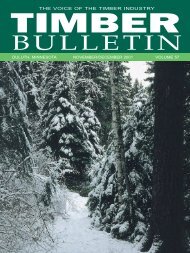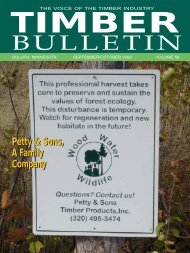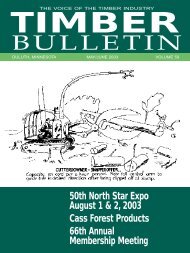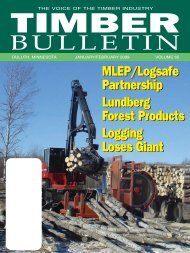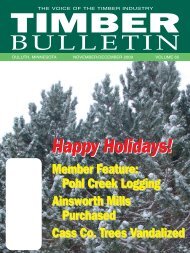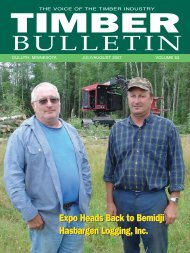Timber Bulletin Nov/Dec - Minnesota Forest Industries
Timber Bulletin Nov/Dec - Minnesota Forest Industries
Timber Bulletin Nov/Dec - Minnesota Forest Industries
You also want an ePaper? Increase the reach of your titles
YUMPU automatically turns print PDFs into web optimized ePapers that Google loves.
percent for many owners, the likely<br />
range of costs for the loss in the<br />
owner’s previous forest investment.<br />
This is often referred to as the size<br />
of the asset taking before any<br />
compensation. To lower the small<br />
landowner losses and reduce the<br />
disparity, Washington now offers<br />
market value compensation to<br />
small owners for 50 percent of<br />
these losses in exchange for<br />
conservation easements up to a<br />
threshold level of about 25 percent<br />
and 100 percent compensation<br />
above this threshold. The buffer<br />
regulations and easement, however,<br />
would appear to reduce any<br />
motivation for small owners to<br />
continue investing in restoration<br />
and thinning operations to grow<br />
larger trees. These increased costs<br />
reduce the profit margin for the<br />
next crop by an even greater<br />
percentage than the loss in the<br />
current crop. The reduction in<br />
returns to future management of<br />
the land was more than twice the<br />
percentage loss in acres impacted<br />
or harvest in cases we analyzed.<br />
<strong>Dec</strong>lining financial returns to<br />
forestry investments relative to<br />
conversion or sale alternatives calls<br />
into question the future viability of<br />
small owner management.<br />
Market Value Benefits<br />
In analyzing the benefits of the<br />
regulations, one estimate of the<br />
potential increase in market value<br />
for fishing interests showed the<br />
timber losses in buffers to be<br />
almost an order of magnitude<br />
larger than the fishery gains and<br />
the gap widened with buffer width.<br />
This suggests that the benefits of<br />
importance are non-market social<br />
values, not non-timber market<br />
values.<br />
Non-Market Value Tradeoffs<br />
Studies that have estimated the<br />
values that various publics place on<br />
forest management and fish are<br />
particularly hard to validate.<br />
Experimental choice surveys that<br />
ask consumers to make choices<br />
among market baskets of<br />
alternatives do provide quantitative<br />
values for their willingness to pay<br />
for forest biodiversity, aesthetics or<br />
fish population recovery and their<br />
willingness to accept job losses or<br />
out-of-pocket costs. Urban<br />
communities place the highest<br />
value on forest aesthetics and<br />
biodiversity associated with older<br />
forests, yet rural communities are<br />
being forced to absorb most of the<br />
costs and job losses associated with<br />
regulatory constraints on forest<br />
harvest. One recent survey shows<br />
each household willing to pay as<br />
much as $344 per year for a<br />
sizeable recovery in migratory fish<br />
populations. <strong>Forest</strong>ry is generally<br />
considered to have a much smaller<br />
impact on fish populations than<br />
other causes, hence the forestry fair<br />
share would be much lower than<br />
this value. Other studies show that<br />
the public’s unwillingness to accept<br />
the job losses and costs that result<br />
from new regulations is greater<br />
than these gains. However, if more<br />
aggressive thinning management<br />
strategies are used to reach desired<br />
habitat characteristics, costs and job<br />
losses are substantially reduced,<br />
creating the potential for net social<br />
gains, although the costs to rural<br />
communities would still be large if<br />
not compensated.<br />
Tentative Conclusions<br />
While Oregon’s new fish<br />
protection rules are still being<br />
deliberated and may be<br />
economically less negative than<br />
Washington’s, tentative conclusions<br />
would include:<br />
• This fish agreement will impact<br />
15-25 percent of the non-federal<br />
forests, although the uncertainty<br />
is still large given the potential<br />
for further regulatory constraints<br />
associated with unstable slopes<br />
and stream typing.<br />
• Wider buffers such as those used<br />
on federal lands are much more<br />
costly.<br />
• Some small owners are<br />
disproportionally impacted, and<br />
while conservation easement<br />
compensation may offset these<br />
impacts, it also reduces the<br />
motivation of small owners to do<br />
any management that would<br />
otherwise contribute to habitat<br />
restoration.<br />
• The reduced returns to small<br />
owner management will likely<br />
increase conversions and land<br />
sales. A thorough examination of<br />
indirect regulatory costs is<br />
critical.<br />
• The low economic efficiency of<br />
no-management buffers offers<br />
promise to more adaptive<br />
management strategies such as<br />
habitat conservation plans.<br />
• Non-timber market gains are<br />
likely to be small relative to<br />
timber losses.<br />
• Non-market social values placed<br />
on forests and fish by the general<br />
public may be sufficient to<br />
generate net social welfare gains<br />
but this would likely require<br />
more active management<br />
alternatives to reduce the<br />
economic losses. These<br />
alternatives are not the norm<br />
under current regulations that are<br />
still predicated largely on nomanagement<br />
reserve strategies<br />
instead of active management<br />
restoration strategies.<br />
• Uncertainties in measuring and<br />
modeling the biological impacts<br />
are still large.<br />
Bruce Lippke is director, Rural<br />
Technology Initiative, College of<br />
<strong>Forest</strong> Resources, University of<br />
Washington.<br />
Court Supports<br />
Boise EAW<br />
Boise Cascade’s Environmental<br />
Assessment Worksheet (EAW) was<br />
affirmed in District Court. The<br />
project, which will make various<br />
improvements in the company’s<br />
International Falls paper mill,<br />
projects the use of up to an<br />
additional 100,000 cords of wood<br />
when completed.<br />
The <strong>Minnesota</strong> Center for<br />
Environmental Advocacy (MCEA)<br />
had contested the project and its<br />
EAW before the MPCA and the<br />
EQB, and finally, by suing in<br />
District Court. Each body had<br />
affirmed the EAW and its<br />
component parts and rejected<br />
MCEA’s views. The main issues<br />
contested by MCEA were the<br />
analysis, conclusions and follow up<br />
to the GEIS.<br />
“We’re pleased that the EQB,<br />
MPCA and now the District Court<br />
have affirmed the Boise project and<br />
the continuing validity of the GEIS.<br />
It’s sad that MCEA and other<br />
environmental groups continue to<br />
pursue challenges, appeals and<br />
litigation instead of helping us<br />
move forward with progressive<br />
forest management,” said Wayne<br />
Brandt, TPA executive vice<br />
president.<br />
16 <strong>Timber</strong> <strong>Bulletin</strong> <strong>Nov</strong>ember/<strong>Dec</strong>ember 2000




